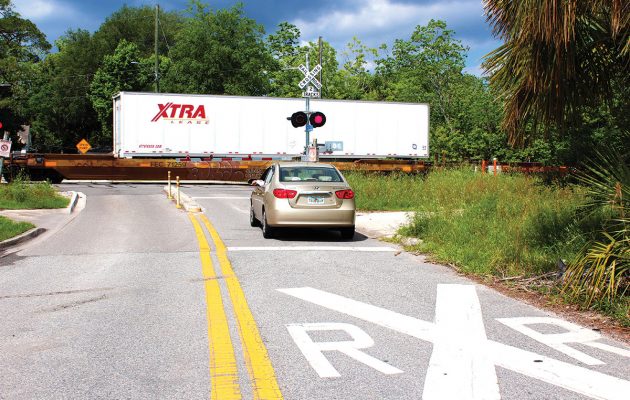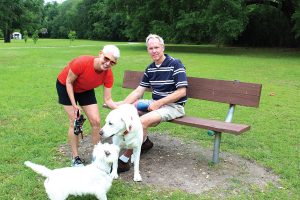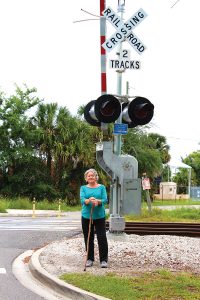Increasing number, length of trains spoil neighborhood ambiance
Posted on May 1, 2018 By Editor Articles, Neighborhood News, Top Stories

Whether you find train horns nostalgic and soothing versus annoying and disruptive seems to be a function of distance. Those who grew up in more rural areas or who remember a time when Jacksonville’s population was much less dense and trains were shorter and ran less frequently recall the melancholy and yet reassuring sound of whistles as steam engines chugged along through distant fields and mountains.
Others, like Lilla Ross, who lives three houses from the railroad crossing on River Oaks Road in San Marco, find the train horns increasingly aggravating, and she is taking steps to do something about the issue.
The Florida East Coast track is part of the history of historic San Marco, and people who live in the neighborhood or who frequent the shopping district are accustomed to the blasts of the horns of passing trains. Train engineers are required by federal regulation to blow the horn four times to alert traffic of their approach at the 10 train crossings between the trestle bridge across the St. Johns River to Emerson Street.
In recent years, the number of trains coming through the neighborhood has increased. The trains are getting longer and louder. Some trains can be as long as a mile and require a larger locomotive to pull them. The larger locomotives have a bass note in their whistle so, while they may stay within the decibel level required by federal regulations, they sound louder. The Federal Railroad Administration regulations require engineers to sound two long, one short and one long horn at each crossing.
“With 24-32 trains traveling through 10 crossings in San Marco every day, that’s as many as 1,500 train horns blown each day,” Ross said. “I’ve lived in San Marco for 40 years and in my current home for 32 years. In the beginning I got used to the horns. But there is a lot more train traffic now.”
Ross is leading an initiative to solve this noise pollution that she and others say interrupts sleep and affects home values. They want to create the San Marco Quiet Zone, like those that are already established all over the country, including Miami, Broward County and Orlando, in our own state.
“I decided to create a website and petition to help spread the word and establish that there is a need for a Quiet Zone. It is affecting the quality of life in the neighborhood,” Ross said. By the end of April, 160 people had signed her www.quietzonejax.com petition.
Quiet zones are regulated by the Federal Railroad Administration. They require that other safety measures be put in place to make it unnecessary for train engineers to blow the horns, except in the case of an emergency. The options are to install lights and four-quadrant gates (four long arms, two each on both sides of the crossing), traffic barriers to stop drivers from going around lowered gates or into opposing lanes of traffic, or close the crossing to vehicular traffic altogether.
The crossings that are included in the San Marco Quiet Zone proposal are Prudential Drive (at Baptist Health), San Marco Boulevard, Nira Street, Naldo Avenue, Hendricks Avenue, Atlantic Boulevard, River Oaks Road, St. Augustine Road, Emerson Street and Reba Avenue (south of Walmart).
Homeowners near the tracks and crossings aren’t the only people interested in the creation of a San Marco Quiet Zone. Developers and people visiting parks and other outdoor public spaces have weighed in on the issue, too.
Chance Partners has started construction on the San Marco Promenade that will open in Summer 2019. The apartments will be on Philips Highway just south of I-95 beside the railroad tracks near the River Oaks Road crossing.
Jeff Rosen, a principal with the firm, said, “Chance Partners is very supportive of the quiet zone efforts and believe it will have a positive impact on all residents throughout San Marco and nearby neighborhoods.”
The firm also has plans for a proposed San Marco Crossing apartment development near their San Marco Promenade location and a second phase of San Marco Promenade in the future.
While The Resident was unable to reach District 5 Councilwoman Lori Boyer for comment, “Ms. Boyer has indicated that she is supportive of a San Marco Quiet Zone,” Ross said.
Funds needed to create Quiet Zone
This is not the first time in recent San Marco history that the idea of a Quiet Zone has been brought to Boyer’s attention. In October 2013, Donald C. Jones, then CEO of the American Association of Clinical Endocrinologists and the American College of Endocrinology, wrote to Boyer to express his frustration about “ear-piercing sounds” that went on 24 hours a day, seven days a week. Like Ross, he had lived on River Oaks Road for more than 40 years and hoped to find a solution because he didn’t want to move.
In a later letter to Boyer, Jones questioned why City Ordinance 2013-676-E, which sets restrictions on noise decibel levels, could not be applied to limit train noise levels in San Marco. He wrote, “This is becoming a health and public safety issue, not to mention an ongoing source of irritation and frustration. The noise levels can cause hearing damage if you are outside.”
Unfortunately, Jones died in July 2017, so he is not part of these new efforts. The biggest impediment to creating a San Marco Quiet Zone seemed to him then, as it does for those currently wanting to pursue this route, to be funding to add the safety measures required by the FRA to make it unnecessary for train engineers to blow the horns.

Park visitors Pam Sorenson and Piper and Earl Higginbotham and Jack in Alexandria Oaks Park near the train track.
All 10 crossings in the current San Marco Quiet Zone proposal have lights and two-quadrant gates (long arm and short arm). River Oaks and Emerson already have traffic barriers. A San Marco Quiet Zone would require new traffic islands and/or upgraded gates at these crossings. The level of upgrade needed at each crossing would determine the cost.
“We hope to develop a public-private partnership, like what was accomplished in south Florida, for funds that will be needed. Public money from city, state and federal governments and perhaps private developers would help,” Ross said.
San Marco resident Earl Higginbotham wonders why train engineers are still required to blow horns at all. “Trains blowing horns is anachronistic,” he said. “They were for remote, rural communities that didn’t have lights and gates at crossings.”
“With all of the warning devices – signs, flashing lights, road impediments and gates – trains shouldn’t need horns,” Higginbotham said. “We drive our cars through many intersections every day and aren’t required to blow our horns to warn pedestrians, because it is their responsibility to obey the walk/don’t walk signs and signal lights.”
Higginbotham is a retired locomotive engineer, attorney and breeder of Dilute (Silver) Chocolate Labrador Retrievers. He lives in Lakewood, but walks his dog, Jack, in Alexander Oaks Park twice a day on most days.
He worked a total of 25 years as an attorney specializing in Federal Employers Liability Act (FELA) practice and all other areas of personal injury and wrongful death. Prior to that he was an associate attorney/manager of labor relations for CSX and general chairman of United Transportation Union. And, he was a locomotive fireman and engineer for Seaboard Coast Line Railroad Company for 10 years.
“A San Marco Quiet Zone would be a great improvement for everyone – businesses, the neighborhood and individuals and visitors to the area,” he said.
When Higginbotham and Jack walk in Alexander Oaks Park, which parallels the train tracks, he said, “Even in the field, the decibel levels are sufficiently high as to almost automatically encourage one to cover one’s ears as the trains approach and transverse River Oaks Road.”
Pam Sorenson lives in The Peninsula condos on the Southbank. “The train horns are particularly aggravating at night,” she said. “The sound ricochets off the water and the high-rise buildings.”
Joe Honeycutt, who signed Ross’ online petition, said, “Our home is about one mile from the railroad crossing at Emerson and the same distance from the St. Augustine Road crossing. We can hear the train horn but it is barely noticeable. I primarily signed the petition because I believe [the sound of train horns] has some effect on property values of the people that live much closer to the crossings.”
Not everyone agrees with the need for a Quiet Zone, however. “Some residents have pointed out to me that I knew I was buying a home next to a railroad track and crossing, so I should just put up with it or move,” Ross said. “That’s easier said than done after living 32 years in one place.”
“I’m aware that some neighbors have actually expressed no concern with the horn noise,” Earl Higginbotham said. “No one can reasonably state a preference for hearing damaging levels of horn exposure to that of peace and quiet.”
Karen J. Rieley
Resident Community News




 (No Ratings Yet)
(No Ratings Yet)





